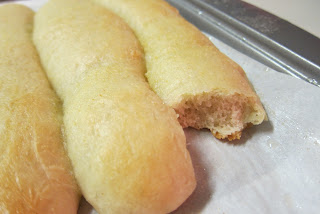
When it comes to Thanksgiving people either usually brine or butter. I like to do both. A few years ago I heard about brining and decided to try it. I've been doing it every year since. It makes a huge difference in the juiciness of your turkey. I like to play around with my brine recipes year to year and see how they turn out. This one is the one I did this year. I'm not sure why it has taken me so long to get this up here either. I gave this one out to friends and family this year too and had no complaints. This is an Anne Burrell recipe from Food Network.
Brine:
7 quarts water
1 quart apple cider
3/4 cup kosher salt
1/3 cup granulated sugar
1 large onion, diced
1 large or 2 small carrots, diced
3 ribs celery, diced
1 head garlic, cut in 1/2 equatorially
1/2 bunch fresh rosemary
1/2 bunch fresh sage
1/2 bunch of thyme
6 bay leaves
1 (12 to 14 pound) turkey
Herb crust:
1 bunch fresh rosemary, leaves finely chopped
1 bunch fresh sage, leaves finely chopped
1 bunch of thyme, finely chopped
3 sticks butter, room temperature
Kosher salt
To brine the turkey: Combine 4 cups of water and salt and sugar in a saucepan and heat until all sugar and salt is completely dissolved. The pour into your big brining bucket with all remaining ingredients and stir to combine. Add the turkey and let it brine in the refrigerator for 48 hours.
To prepare the turkey for cooking: Remove the turkey from the brine about 6-10 hours before you are going to cook it. I usually take it out first thing in the morning around 7am, but if you are going to cook it early you can do this the night before. pat it thoroughly dry with paper towels. Combine the rosemary, sage, thyme and (room temperature) butter for the herb crust in a small bowl. Season, to taste, with kosher salt. Work the butter under the skin of the turkey and massage it into the breasts and the legs. Massage the butter on the outside of the skin as well. Tie the legs together over the breast so they will protect it during cooking and help keep it moist and juicy.
Arrange your turkey on top of the vegetables you plan on roasting with it and refrigerate overnight UNCOVERED! Yes, that's right, uncovered. This will help the skin dry out and become really brown and crispy. Make sure that there is no raw food near the turkey in the refrigerator. After refrigerating overnight, the turkey is ready to go in the oven.
Preheat the oven to 450 degrees F. Put 3 cups chicken stock in the bottom of the roasting pan. Roast the turkey in the preheated oven until the skin gets really nice and brown, about 40 minutes. Lower the oven heat to 350 degrees F for the remainder of the cooking time. Baste the turkey every 30 minutes or so and add more stock to the roasting pan, if needed. Cook about 17 minutes per pound. Once it gets to the proper color, tent the turkey with aluminum foil to prevent it from getting too dark.
Remove the turkey from the oven when an instant-read thermometer inserted in the thickest part of the turkey registers 160 degrees F. Make sure that the thermometer is not touching a bone when doing the reading. When the turkey has reached the proper temperature, remove it from the roasting pan to a cutting board and let it rest for at least 30 minutes. Cover loosely with aluminum foil.
Strain all the veggies over a bowl to separate them from the stock/mixture. Discard the veggies. Skim off the fat and add it to the roasting pan. This is the fat for the roux. Put the roasting pan over 2 burners and over a low heat and whisk in the flour. Cook until the mixture looks like wet sand, about 4 to 5 minutes. Slowly whisk in the remaining 1 cup chicken stock (or white wine if preferred). Cook until the mixture has thickened and reached a gravy consistency. Taste and adjust the seasoning. Pour into a serving pitcher or bowl.

 Bring the almond milk to a boil and add in your oats. Cook according to the package instructions, about 5-8 minutes, stirring occasionally. Turn on low and add in your cinnamon and vanilla extract and stir. Then add an entire banana. I usually just break it up into a few pieces. Then I use a potato masher and mash the banana into the oatmeal. The riper the banana the better as you won't need any extra sweetener if your banana is at its ripest. Then top with a few slices of banana if you want and some slivered almonds. Add a teaspoon or two of maple syrup on the top for extra sweetness if needed.
Bring the almond milk to a boil and add in your oats. Cook according to the package instructions, about 5-8 minutes, stirring occasionally. Turn on low and add in your cinnamon and vanilla extract and stir. Then add an entire banana. I usually just break it up into a few pieces. Then I use a potato masher and mash the banana into the oatmeal. The riper the banana the better as you won't need any extra sweetener if your banana is at its ripest. Then top with a few slices of banana if you want and some slivered almonds. Add a teaspoon or two of maple syrup on the top for extra sweetness if needed. 
















